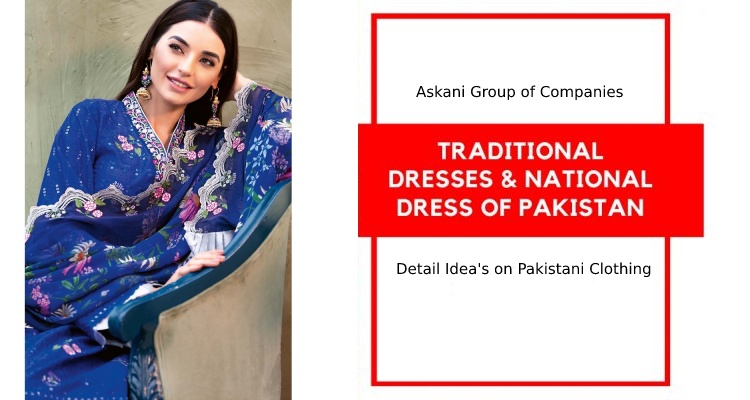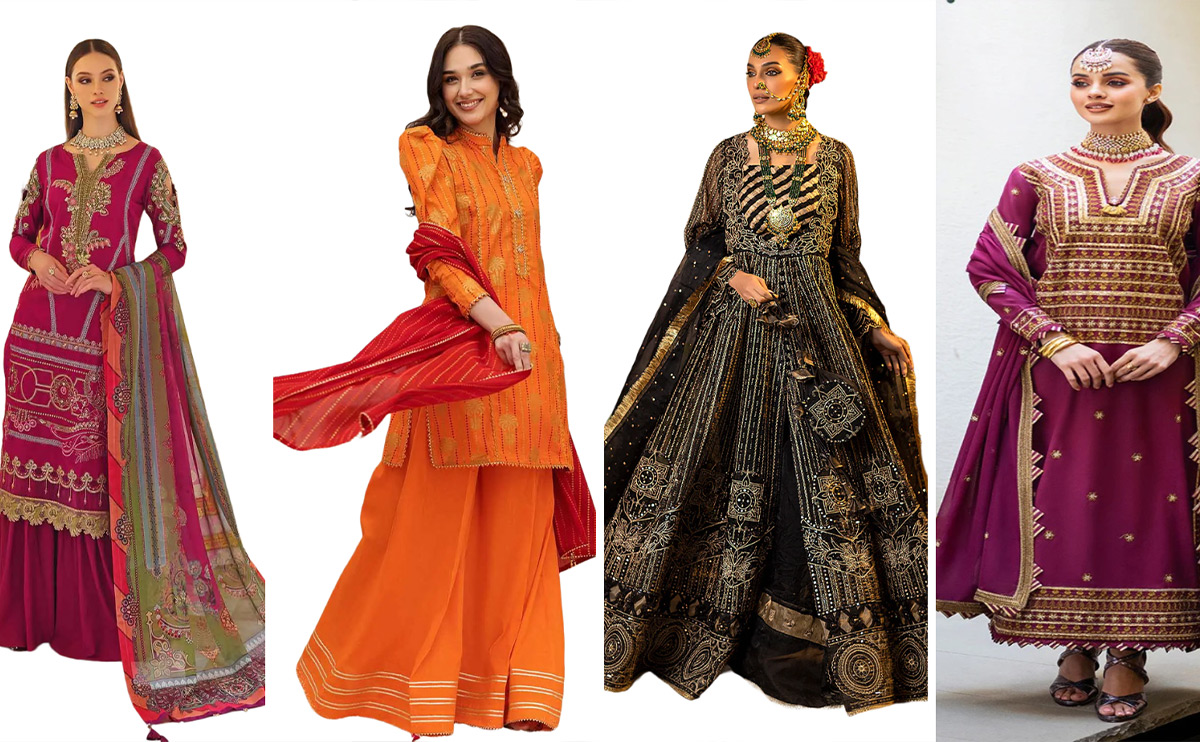[vc_row][vc_column][vc_column_text]
Pakistan’s culture is rich in the traditions of peoples and represents the history of the region. The Pakistani people and society are unique in their way of life, ideas and ethics. Pakistani clothing reflects the culture of Pakistan and the culture of those provisions Punjab, Sindh, Balochistan, Khyber Pakhtunkhwa (Pashtun) and Kashmir areas of the country. People love the national dress of Pakistan.
The clothing culture of the Pakistani people is en0riched by various influences of thousands of years of old heritage. Clothing is the identity of any nation. The dress is in each regional culture reflects the climatic conditions, lifestyle and specific style that gives it a distinct identity in all cultures.
[/vc_column_text][/vc_column][/vc_row][vc_row][vc_column][vc_custom_heading text=”National Dress of Pakistan:” font_container=”tag:h1|text_align:left|color:%23dd3333″][/vc_column][/vc_row][vc_row mobile_bg_img_hidden=”no” tablet_bg_img_hidden=”no” woodmart_parallax=”0″ woodmart_gradient_switch=”no” row_reverse_mobile=”0″ row_reverse_tablet=”0″ woodmart_disable_overflow=”0″][vc_column][vc_column_text woodmart_inline=”no” text_larger=”no”]
The shalwar kameez is the national dress of Pakistan and worn by men and women in all five provinces. Since 1982, all Government officials working in the Secretariat have required to wear the national dress. Each province has its own style of wearing a shalwar kameez famous for Sindhi shalwar kameez, Punjabi shalwar kameez, Balochi shalwar kameez and Pashtun shalwar kameez.
[/vc_column_text][/vc_column][/vc_row][vc_row][vc_column][vc_custom_heading text=”Shalwar Kameez For Women:” font_container=”tag:h2|text_align:left|color:%23dd3333″][/vc_column][/vc_row][vc_row][vc_column][woodmart_products layout=”carousel” speed=”2000″ items_per_page=”100″ orderby=”rand” taxonomies=”18″ autoplay=”yes” hide_pagination_control=”no” hide_prev_next_buttons=”no” center_mode=”no” wrap=”yes” sale_countdown=”0″ stock_progress_bar=”0″ highlighted_products=”0″ products_bordered_grid=”0″ lazy_loading=”no” scroll_carousel_init=”yes” woodmart_css_id=”62c2a0c793ed8″ hide_out_of_stock=”no” responsive_spacing=”eyJwYXJhbV90eXBlIjoid29vZG1hcnRfcmVzcG9uc2l2ZV9zcGFjaW5nIiwic2VsZWN0b3JfaWQiOiI2MmMyYTBjNzkzZWQ4Iiwic2hvcnRjb2RlIjoid29vZG1hcnRfcHJvZHVjdHMiLCJkYXRhIjp7InRhYmxldCI6e30sIm1vYmlsZSI6e319fQ==”][/vc_column][/vc_row][vc_row][vc_column][vc_column_text woodmart_inline=”no” text_larger=”no”]
Pakistani women wear shalwar kameez which wear in different styles, colors and designs decorated with different styles and embroidery designs. The length of the shirt sleeve, the length of the shirt, can vary in the neckline. Long straight cut trousers, Patiala Shalwar, Tulip Trousers, Churidar, Cigarette Pajamas, Samosa Pajamas or Plain Pants.
[/vc_column_text][/vc_column][/vc_row][vc_row][vc_column][vc_custom_heading text=”Shalwar Kameez And Kurta For Men:” font_container=”tag:h2|text_align:left|color:%23dd3333″][/vc_column][/vc_row][vc_row][vc_column][woodmart_products layout=”carousel” speed=”2000″ items_per_page=”100″ orderby=”rand” woodmart_css_id=”62c2a035b078a” taxonomies=”933″ autoplay=”yes” hide_pagination_control=”no” hide_prev_next_buttons=”no” center_mode=”no” wrap=”yes” sale_countdown=”0″ stock_progress_bar=”0″ highlighted_products=”0″ products_bordered_grid=”0″ hide_out_of_stock=”no” lazy_loading=”no” scroll_carousel_init=”yes” responsive_spacing=”eyJwYXJhbV90eXBlIjoid29vZG1hcnRfcmVzcG9uc2l2ZV9zcGFjaW5nIiwic2VsZWN0b3JfaWQiOiI2MmMyYTAzNWIwNzhhIiwic2hvcnRjb2RlIjoid29vZG1hcnRfcHJvZHVjdHMiLCJkYXRhIjp7InRhYmxldCI6e30sIm1vYmlsZSI6e319fQ==”][/vc_column][/vc_row][vc_row][vc_column][vc_column_text woodmart_inline=”no” text_larger=”no”]
Mostly Pakistani men wear Shalwar Kameez and some also wear Kurta and Shalwar Pakistani Waistcoat. The kurta is also an important traditional clothing item in Pakistan. It looks like a sack that encloses with a drawstring. The length of the kurta extends to the wearer’s knees. Kurta can wear with trousers or jeans. Men also like to wear a waistcoat with a kurta and a shalwar kameez and Pajama. It makes the dress look very dashing look.
[/vc_column_text][/vc_column][/vc_row][vc_row][vc_column][vc_custom_heading text=”Sherwani:” font_container=”tag:h2|text_align:left|color:%23dd3333″][/vc_column][/vc_row][vc_row][vc_column][vc_single_image image=”9735″ img_size=”full” alignment=”center” woodmart_inline=”no” parallax_scroll=”no”][/vc_column][/vc_row][vc_row][vc_column][vc_column_text woodmart_inline=”no” text_larger=”no”]
Sherwani is basically a long coat that is usually below the knee length. It is one of the most dressed for her special occasion and sets you apart from the rest of the world. It is a traditional clothing blend with Eastern aesthetics and a symbol of cultural ethics. Sherwani is the most common dress in men’s weddings. It is usually made of fine thread, goldwork or embroidery. In general, the gold, white and black sherwani are commonly used.
After the independence of Pakistan, Muhammad Ali Jinnah often wore sherwani. Following in his footsteps, most people and government officials in Pakistan, such as the president and prime minister, began to wear the regular black sherwani on shalwar kameez for state occasions and national holidays.
[/vc_column_text][/vc_column][/vc_row][vc_row][vc_column][vc_custom_heading text=”Regional Clothing:” font_container=”tag:h2|text_align:left|color:%23dd3333″][/vc_column][/vc_row][vc_row][vc_column][vc_column_text woodmart_inline=”no” text_larger=”no”]
In regional dress, the Baloch wear thick fabric shalwar kameez with very wide shalwars to protect themselves from the dry Sulaiman Range and the hot winds of the Kharan Desert. They wear a long-sleeved Balochi turban, often white to protect their heads from the sun’s rays.
Sindhi people wear shalwar kameez with traditional Sindhi hat and ajrak of beautiful locally made designs. Punjabi men wear simple shalwar kameez, shalwar and dhoti karta according to Punjabi climate. A thin cloth turban is also used along with a shalwar kameez, especially in the rural areas of Punjab where it is called a turban. Khussa is also used with dhoti kurta. In Pashtun dress, people wear traditional professional slippers.
By women’s religious dress we mean the dressing in which they try to cover all parts of their body except the face and hands when they go out of the house. Most women cover their heads with a Dupatta or Chador outside or in whole or in part, but religious women prefer to wear a Scarf, Burqa or Hijab.
[/vc_column_text][/vc_column][/vc_row][vc_row][vc_column][vc_custom_heading text=”Traditional Dresses:” font_container=”tag:h2|text_align:left|color:%23dd3333″][/vc_column][/vc_row][vc_row][vc_column][vc_single_image image=”9737″ img_size=”full” alignment=”center” woodmart_inline=”no” parallax_scroll=”no”][/vc_column][/vc_row][vc_row][vc_column][vc_column_text woodmart_inline=”no” text_larger=”no”]
Each country has its own traditional dress. The same is true of Pakistan. Our traditional dress is shalwar kameez. It is good for all men, women and children of Pakistan. It wears and is equally popular in all provinces (Punjab, Sindh, Balochistan, KPK), cities and villages of Pakistan.
[/vc_column_text][/vc_column][/vc_row][vc_row][vc_column][vc_custom_heading text=”Sindh:” font_container=”tag:h2|text_align:left|color:%23dd3333″][/vc_column][/vc_row][vc_row][vc_column][vc_single_image image=”9739″ img_size=”full” alignment=”center” woodmart_inline=”no” parallax_scroll=”no”][/vc_column][/vc_row][vc_row][vc_column][vc_column_text woodmart_inline=”no” text_larger=”no”]
Sindhis wear a version of the shalwar called Suthan which had a shirt called Cholla. Other traditional clothing includes Sindhi hats and Ajrak beautiful designs that are made locally. Men also traditionally wear a dhoti.
Sindhi women wear lenga and choli called gaji which is a mountain shirt wear in hilly areas of Sindh. Gaji consists of small, square panels, embroidered on silk and sequins. Sindhi dress shows embroidery using a mirror.
[/vc_column_text][/vc_column][/vc_row][vc_row][vc_column][vc_custom_heading text=”Punjab:” font_container=”tag:h2|text_align:left|color:%23dd3333″][/vc_column][/vc_row][vc_row][vc_column][vc_single_image image=”9741″ img_size=”full” alignment=”center” woodmart_inline=”no” parallax_scroll=”no”][/vc_column][/vc_row][vc_row][vc_column][vc_column_text woodmart_inline=”no” text_larger=”no”]
Punjabi men wear straight cut Punjabi shalwar kameez, kurta, dhoti and lungi. Other Punjabi shalwar styles include Pothohari Shalwar, Multani Shalwar and Bahawalpuri Shalwar which is very wide and rich in many layers. A thin turban is also worn especially in rural areas of Punjab where it is called pagri with khussa.
Punjabi women wear straight cut Punjabi shalwar kameez, which is often wear. In rural areas, Punjabi women wear Pothohari shalwar, Patiala shalwar, laacha, gagra, kurti, lehenga and phulkari.
[/vc_column_text][/vc_column][/vc_row][vc_row][vc_column][vc_custom_heading text=”Khyber Pakhtunkhwa (KPK)” font_container=”tag:h2|text_align:left|color:%23dd3333″][/vc_column][/vc_row][vc_row][vc_column][vc_single_image image=”9744″ img_size=”full” alignment=”center” woodmart_inline=”no” parallax_scroll=”no”][/vc_column][/vc_row][vc_row][vc_column][vc_column_text woodmart_inline=”no” text_larger=”no”]
In Pashtun dress, people wear traditional Peshawari chappal. Traditional men’s Pashtun clothing includes khet purtag and Peshawari shalwar. Men usually wear traditional headgear with a traditional forehead hat, turban.
In urban areas, women usually wear shalwar kameez. Pashtun women usually wear shalwar kameez, and in some areas, especially in the tribal areas, women wear firaq partug. In the Kalash region, women wear long embroidered shirts.
[/vc_column_text][/vc_column][/vc_row][vc_row][vc_column][vc_custom_heading text=”Balochistan:” font_container=”tag:h2|text_align:left|color:%23dd3333″][/vc_column][/vc_row][vc_row][vc_column][woodmart_products layout=”carousel” speed=”2000″ items_per_page=”100″ orderby=”rand” woodmart_css_id=”62c2a14558994″ taxonomies=”1181″ autoplay=”yes” hide_pagination_control=”no” hide_prev_next_buttons=”no” center_mode=”no” wrap=”yes” sale_countdown=”0″ stock_progress_bar=”0″ highlighted_products=”0″ products_bordered_grid=”0″ hide_out_of_stock=”no” lazy_loading=”no” scroll_carousel_init=”yes” responsive_spacing=”eyJwYXJhbV90eXBlIjoid29vZG1hcnRfcmVzcG9uc2l2ZV9zcGFjaW5nIiwic2VsZWN0b3JfaWQiOiI2MmMyYTE0NTU4OTk0Iiwic2hvcnRjb2RlIjoid29vZG1hcnRfcHJvZHVjdHMiLCJkYXRhIjp7InRhYmxldCI6e30sIm1vYmlsZSI6e319fQ==”][/vc_column][/vc_row][vc_row][vc_column][vc_column_text woodmart_inline=”no” text_larger=”no”]
A Baloch wears a long jama such as a smoky frock up to the heels, a loose shalwar, a long chadar or scarf, a cotton cloth turban, and most of the shoes that float under the feet.
The clothes of the people of Balochistan consist of different types of shirts and shalwars, turbans, shoes and headscarf. Balochi women wear heavily embroidered shalwar kameez and dupatta with embroidery in which they use shisha work. Balochi Dutch, a famous Balochi dresses, is too much expensive and it takes months to complete a single Balochi suit.
[/vc_column_text][/vc_column][/vc_row][vc_row][vc_column][vc_custom_heading text=”List Of National Clothes Of Pakistan:” font_container=”tag:h2|text_align:left|color:%23dd3333″][/vc_column][/vc_row][vc_row][vc_column][vc_column_text woodmart_inline=”no” text_larger=”no”]
- Shalwar kameez
- Sherwani
- Sindhi Ajrak or Cap
- Punjabi kurta and tehmat
- Saraiki Turban
- Saraiki Kurta
- Peshawari Turban
- Lehenga Choli
- Churidaar Pajama
- Ghagra choli
- Dupatta
- Lehenga style sari
- Sindhi lehenga, choli
- Phulkari
- Kalash women traditional clothing
[/vc_column_text][/vc_column][/vc_row]


